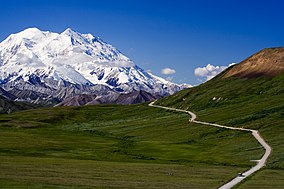Denali Park, Alaska
| Denali National Park and Preserve | |
|---|---|
|
IUCN category VI (protected area with sustainable use of natural resources)
|
|

Denali is located in Denali National Park and is the tallest peak in North America
|
|
| Location | Denali Borough and Matanuska-Susitna Borough, Alaska, United States |
| Nearest city | Healy |
| Coordinates | 63°20′N 150°30′W / 63.333°N 150.500°WCoordinates: 63°20′N 150°30′W / 63.333°N 150.500°W |
| Area | 4,740,911 acres (19,185.79 km2) (park) and 1,304,242 acres (5,278.08 km2) (preserve) |
| Established | February 26, 1917 |
| Visitors | 587,412 (in 2016) |
| Governing body | National Park Service |
| Website | Denali National Park and Preserve |
Denali National Park and Preserve is a national park and preserve located in Interior Alaska, centered on Denali, the highest mountain in North America. The park and contiguous preserve encompasses more than 6 million acres (24,500 km2). The national preserve is 1,334,200 acres (5,430 km2). On December 2, 1980, a 2,146,580 acre (8,687 km2) Denali Wilderness was established within the park. Denali's landscape is a mix of forest at the lowest elevations, including deciduous taiga. The preserve is also home to tundra at middle elevations, and glaciers, rock, and snow at the highest elevations. The longest glacier is the Kahiltna Glacier. The park received 587,412 recreational visitors in 2016. Wintertime activities includes dog-sledding, cross-country skiing, and snowmachining.
Human habitation in the Denali Region extends to more than 11,000 years before the present, with documented sites just outside park boundaries dated to more than 8,000 years before present. However, relatively few archaeological sites have been documented within the park boundaries, owing to the region's high elevation, with harsh winter conditions and scarce resources compared to lower elevations in the area. The oldest site within park boundaries is the Teklanika River site, dated to about 7130 BC. More than 84 archaeological sites have been documented within the park. The sites are typically characterized as hunting camps rather than settlements, and provide little cultural context. The presence of Athabaskan peoples in the region is dated to 1,500 - 1,000 years before present on linguistic and archaeological evidence, while researchers have proposed that Athabaskans may have inhabited the area for thousands of years before then. The principal groups in the park area in the last 500 years include the Koyukon, Tanana and Dena'ina people.
...
Wikipedia

